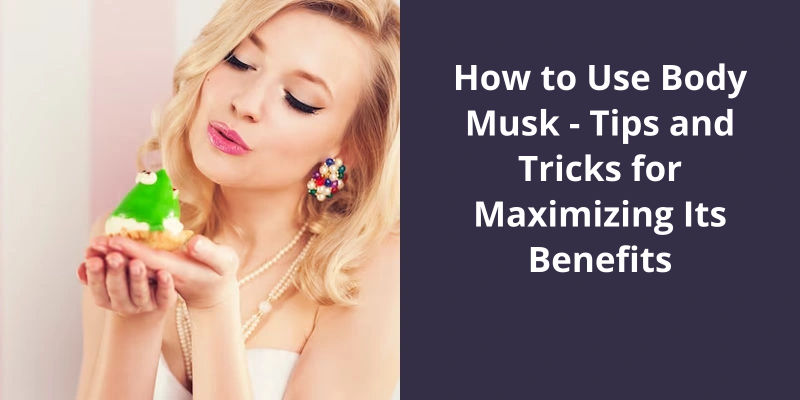Using body musk involves a few simple steps. Initially, you should apply the product right after showering or bathing, as the clean and warm skin can better absorb the scent. Always focus on pulse points like wrists, behind your ears, at the base of your throat, inside your elbow, and behind your knees. These warm areas help diffuse the fragrance across your body. Moreover, avoid rubbing the application spots, as this can make the scent fade faster. Lastly, keep in mind, the strength of the musk can change based on your body chemistry, so it’s advisable to trial a few types and choose one that suits you best.

What Is a Body Musk?
It’s often used as a base in perfumes, lotions and other personal care items. Body Musk can also come in a wide variety of scents and notes that are used in different applications. Some of the popular notes that are used in body musks include rose, jasmine, lavender, sandalwood, patchouli, and vanilla. These notes help create a mesmerizing fragrance that’s perfect for use in a variety of settings.
Often, it’s best applied directly after a shower, as the pores of the skin are open and can absorb the fragrance more easily. When applied correctly, Body Musk can last for several hours, and even up to a day in some cases.
In addition to it’s fragrance benefits, Body Musk has also been known to have calming effects on those who use it. The scent can help reduce stress levels and create a sense of relaxation, making it a popular choice for those who lead busy or stressful lives.
It’s multi-functional application has made it popular choice with many perfume manufacturers who’ve incorporated it into their lines. Despite it being around for many years, it still remains one of the most popular fragrances amongst perfume lovers around the world.
As we delve deeper into discussing musk, opinions on whether it’s a good or bad smell begin to surface. While some people may find it alluring and intoxicating, others might find it too strong and unpleasant. Nonetheless, there’s no denying that musk is a unique scent that doesn’t compare to any other fragrance out there. In fact, it’s so distinct that it’s difficult to put into words.
Is Musk a Good or Bad Smell?
However, whether musk is considered a good or bad smell is highly subjective and depends on personal preferences and cultural associations. Musk has a long history in perfumery and has been used for thousands of years, dating back to ancient times. It was originally obtained from the glands of male musk deer and was considered a luxurious and exotic ingredient.
It’s used as a base note in many fragrances, adding depth and warmth to the scent. Some people find musk fragrances too overpowering and unpleasant, while others enjoy the bold and stimulating aroma.
There are also cultural differences in the perception of musk. In Western cultures, musk is often associated with masculinity and seduction, while in some Eastern cultures, it’s associated with femininity and elegance.
It can be a divisive fragrance, with some people loving it and others finding it unpleasant. The important thing is to wear what makes you feel confident and comfortable, whether it’s a musk-based fragrance or something completely different.
The Different Types of Musk Used in Fragrances and Their Characteristics
- White Musk – Soft, subtle and animalistic aroma
- Ambrette Musk – Sweet, creamy and musky aroma
- Tonkin Musk – Earthy, leathery and animalistic aroma
- Black Musk – Strong, deep and intense aroma
- Castoreum Musk – Warm, rich and woody aroma
- Deer Musk – Sweet, sensual and musky aroma
- Civet Musk – Animalistic, musky and pungent aroma
Source: What does musk smell like?..
Beyond it’s use in fragrances and perfumes, musk has long been utilized for it’s medicinal properties. Dried musk is a key ingredient in a range of remedies, sought after by those who suffer from various health issues including heart and circulation problems, nerve problems, and even seizures. In addition, musk is used to add flavor to foods, adding to it’s versatility. Let’s take a closer look at how this natural substance is used in traditional medicine and beyond.
How Do You Use Musk?
Musk is an aromatic substance that’s been used in traditional Chinese medicine for centuries. The musk deer, a small, herbivorous mammal found in high altitudes in the Himalayas and other parts of Asia, produces musk. The glandular secretion from the musk deer’s musk gland is primarily used for it’s medicinal value. Musk has a unique fragrance and is known for it’s calming and soothing properties.
Some of the most commonly treated conditions include stroke, coma, nerve problems, seizures, heart and circulation problems, tumors, and injuries. Traditional Chinese medicine practitioners typically prescribe musk in powder form, which can be mixed into beverages or applied topically to the skin. When ingested, musk is believed to help promote a sense of calmness and relaxation, while also improving mental clarity and focus. When applied topically, musk is thought to help alleviate pain, swelling, and inflammation.
In many cases, musk is used in conjunction with other flavorings, such as cinnamon, ginger, or cardamom, to create complex and flavorful dishes.
The Ethical Issues Surrounding the Harvesting of Musk From Musk Deer
The musk harvested from musk deer raises ethical concerns, as the process involves killing the animals and their populations are declining.
Now that we’ve a basic understanding of what musk is and where it comes from, let’s explore the different types of musk scents and their unique characteristics.
What Is in Musk Scent?
The most well-known musk scent is that of the musk deer, a small mammal native to Asia. The deers musk is produced in a gland located at the base of the males abdomen, and it’s harvested by killing the animal and removing the gland. This method has led to a significant decrease in the musk deer population and is now illegal in many countries. In response, synthetic musks have been developed to mimic the scent of the original, but without harming animals.
Synthetic musks are made using a variety of chemicals, including nitro-musks, polycyclic musks, and macrocyclic musks.
In addition to animal- and synthetic-derived musk, some plants also emit musky fragrances. One example is the Angelica plant, which is native to Europe and Asia and is commonly used in traditional Chinese medicine. Other plants with musky scents include patchouli, vetiver, and ambrette seeds. These fragrances are often used in perfumery and other cosmetic products for their warm, sensual, and earthy tones.
Despite it’s popularity in perfumery, musk has been criticized for being a potential allergen and for being responsible for causing animal cruelty. Some synthetic musks have also been shown to be persistent in the environment and to accumulate in aquatic organisms, leading to concerns about their effects on human health and the environment. However, ongoing research and development of sustainable and eco-friendly alternatives aim to address these concerns.
The History and Culture of Musk Scent and It’s Uses in Various Cultures.
This topic explores the fascinating history and cultural significance of musk scent across various civilizations. From Ancient Egypt to modern-day perfumery, musk has been used for a variety of purposes including as a symbol of wealth, as a medicinal ingredient, and as an aphrodisiac. This topic delves into the evolution of musk use, it’s impact on different cultures, and the science behind it’s unique scent.
Aside from it’s benefits in skin care, musk has a long history of use in perfumes and fragrances due to it’s unique scent. However, in recent years, concerns have been raised about the ethical implications of using animal-derived musk in skincare and fragrance products. As a result, many companies now use synthetic musk in their products instead. Despite this controversy, there’s no denying the potential benefits that pure musk oil can bring to our skin.
Is Musk Good for the Skin?
Musk oil is extracted from the glands of musk deer and has been used in traditional medicine for hundreds of years. In modern times, musk oil has become a popular ingredient in skin care due to it’s natural properties that benefit our skin. The oil contains a high concentration of antioxidants that help to fight against free radicals that damage our skin, making it a powerful anti-aging ingredient.
It can reduce redness and swelling, making it an excellent oil for those with acne-prone or sensitive skin. The oil is also known to improve the skins natural moisture barrier, helping to keep it hydrated and nourished.
These plant-based oils work together to detoxify and purify the skin, while providing essential vitamins and minerals that our skin needs.
While musk oil is a safe and natural ingredient for most people, it’s important to be aware of any potential allergies or reactions. It’s always a good idea to do a patch test on a small area of skin before using it on your face or body. Additionally, it’s important to only use high-quality, pure musk oil to ensure that you’re getting all of the benefits without any harmful additives.
It can help to improve the overall health and appearance of our skin, while providing essential nutrients and hydration.
The History and Cultural Significance of Musk Oil in Traditional Medicine.
- Musk oil has been used for thousands of years in traditional medicine.
- It was highly valued in ancient civilizations such as the Egyptians, Greeks, and Chinese.
- In traditional Chinese medicine, musk oil was used to treat a variety of ailments including respiratory issues, digestive problems, and headaches.
- In Ayurvedic medicine, musk oil was believed to have anti-inflammatory properties and was used to treat arthritis and other inflammatory conditions.
- Musk oil was also used as an aphrodisiac and is still used in some perfumes for this purpose.
- Today, musk oil is a highly regulated substance and is no longer widely used in traditional medicine.
Conclusion
In conclusion, the use of body musk is a personal choice that’s best determined by individual preferences and circumstances. Firstly, it’s important to with moderation and in appropriate doses to avoid overpowering others or causing irritation. Additionally, it’s important to choose the right type of body musk that complements your natural body odor and suits your skin type. Ultimately, the key to successfully using body musk is to approach it with an open mind, experiment with different products and techniques, and find what works best for you.





